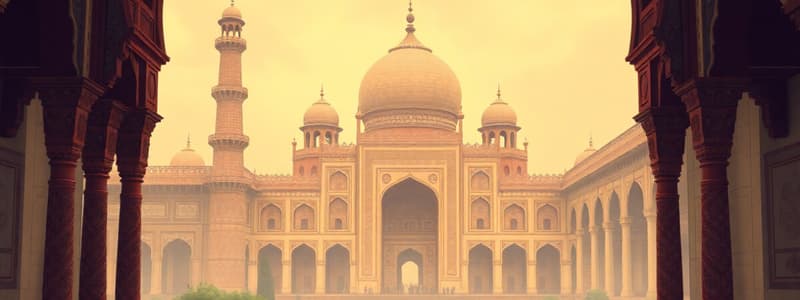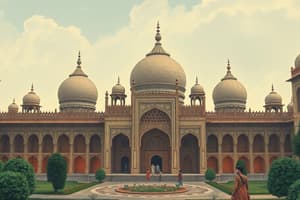Podcast
Questions and Answers
Which of the following scenarios best exemplifies the concept of competitive party systems in a democracy?
Which of the following scenarios best exemplifies the concept of competitive party systems in a democracy?
- A nation where a single political party has maintained power for several decades due to historical dominance.
- A region where only candidates approved by a religious authority are allowed to participate in elections.
- A state where the military directly controls the government and suppresses all forms of political opposition.
- A country where multiple parties contest elections regularly, and power alternates between different coalitions. (correct)
What is the most significant challenge faced by newly independent nations in establishing a stable democracy?
What is the most significant challenge faced by newly independent nations in establishing a stable democracy?
- Prioritizing military strength to deter external threats.
- Adopting a fully socialist system to redistribute wealth immediately.
- Ensuring rapid economic growth through unregulated markets.
- Balancing the demands of various ethnic and social groups while building a unified national identity. (correct)
In the context of coalition governments, which factor most often leads to instability?
In the context of coalition governments, which factor most often leads to instability?
- A high degree of ideological compatibility among coalition partners.
- The presence of strong, centralized leadership within the dominant party.
- A clear and decisive mandate from the electorate.
- Conflicting policy agendas and power struggles among coalition members. (correct)
What is the likely outcome of a country's electoral system if it disproportionately favors larger parties, making it difficult for smaller parties to gain representation?
What is the likely outcome of a country's electoral system if it disproportionately favors larger parties, making it difficult for smaller parties to gain representation?
Consider a scenario where a country transitions from an authoritarian regime to a democracy. Which of the following is the MOST critical factor for ensuring a successful and sustainable democratic transition?
Consider a scenario where a country transitions from an authoritarian regime to a democracy. Which of the following is the MOST critical factor for ensuring a successful and sustainable democratic transition?
Flashcards
What defines a 'State'?
What defines a 'State'?
A state possesses a defined territory, a permanent population, a government, and the capacity to enter into relations with other states; key actor in international relations.
What is Sovereignty?
What is Sovereignty?
Sovereignty is the supreme authority within a territory; implies ultimate control over a state's internal affairs and foreign policy.
What was the Cold War?
What was the Cold War?
The Cold War was a period of geopolitical tension between the United States and the Soviet Union and their respective allies, the Western Bloc and the Eastern Bloc, from the mid-1940s until the dissolution of the Soviet Union in 1991.
What is Non-Alignment?
What is Non-Alignment?
Signup and view all the flashcards
What is Globalization?
What is Globalization?
Signup and view all the flashcards
Study Notes
- Nation-Building and Its Challenges
Challenges of Nation-Building
- India faced three key challenges immediately after independence: shaping a united nation, establishing democracy, and ensuring development and well-being for the entire society.
- The partition of India in 1947 resulted in large-scale displacement and violence, posing a significant challenge to national unity.
- Integrating princely states into the Union of India was crucial for territorial integrity.
- Establishing democratic governance required framing a constitution and holding free and fair elections.
- Economic development aimed at alleviating poverty and social inequalities was vital for long-term stability.
Partition: Displacement and Rehabilitation
- The partition led to one of the largest, most abrupt, unplanned and tragic transfers of population in human history
- Partition was not just a division of properties, liabilities and assets, but also a violent division of communities who had hitherto lived together as neighbours
- People of different religions were rendered refugees in their own land
- The challenge of rehabilitation of these refugees was so grim
- Women were often abducted, raped and even killed
- Thousands of children were orphaned
Integration of Princely States
- The British India was divided into British Indian provinces and Princely States.
- Sardar Vallabhbhai Patel played a crucial role in negotiating with the rulers of princely states to join the Indian Union.
- Most princely states acceded to India peacefully, but challenges arose with states like Junagadh, Hyderabad, Kashmir, and Manipur.
- The government used diplomacy and, when necessary, military intervention to ensure their integration.
The Question of Jammu and Kashmir
- Jammu and Kashmir's accession to India was complex due to its Hindu ruler and Muslim-majority population.
- Initial reluctance of the ruler to join either India or Pakistan led to Pakistani incursions.
- Maharaja Hari Singh signed the Instrument of Accession with India, leading to Indian military intervention.
- This resulted in a long-standing dispute, with parts of the state under Pakistani control.
Political Formation
Organisation of States
- The reorganization of states began in 1953 with the formation of Andhra Pradesh, created out of Telugu-speaking areas of the Madras State.
- The States Reorganisation Commission was established to redraw the boundaries of states based on linguistic lines.
- The commission's recommendations were implemented in 1956, leading to the creation of 14 states and 6 union territories.
The Era of One-Party Dominance
-
The Indian National Congress dominated Indian politics in the initial years after independence.
-
Factors contributing to Congress dominance included its role in the freedom movement and the charismatic leadership of Jawaharlal Nehru.
-
The dominance of the Congress Party did not mean the absence of opposition parties.
-
Socialist, communist, and other parties existed, offering alternative ideologies and criticisms of Congress policies.
-
Despite its dominance, the Congress Party accommodated various factions and interests, making it a broad-based coalition.
-
Politics of Planned Development
Planning
- After independence, India adopted economic planning to accelerate development and reduce poverty.
- The Planning Commission was established in 1950 to formulate Five-Year Plans.
- The First Five-Year Plan (1951-1956) focused on agriculture, while the Second Five-Year Plan (1956-1961) emphasized industrialization.
- India followed a mixed economy model, combining elements of both capitalist and socialist approaches.
- Land reforms, including abolition of zamindari, aimed to redistribute land and empower farmers.
Green Revolution
- The Green Revolution in the 1960s introduced high-yielding varieties of seeds and modern agricultural techniques.
- It significantly increased food production, making India self-sufficient in food grains.
- However, it also led to regional disparities and environmental concerns due to overuse of fertilizers and pesticides.
India’s External Relations
Nehru’s Foreign Policy
- Jawaharlal Nehru played a key role in shaping India's foreign policy.
- Nehru's foreign policy was based on non-alignment, Panchsheel, and anti-colonialism.
- Non-alignment meant not joining any military alliance led by the US or the Soviet Union.
- Panchsheel, or the Five Principles of Peaceful Coexistence, guided India's relations with China and other countries.
- India actively supported decolonization movements in Asia and Africa.
India-China Relations
- Initially, India and China had cordial relations, symbolized by the slogan "Hindi-Chini bhai-bhai."
- However, border disputes and China's support to Pakistan led to deteriorating relations.
- The Sino-Indian War of 1962 resulted in a setback for India and strained relations.
Wars and Peace with Pakistan
- India and Pakistan have been involved in several conflicts, including wars in 1947-48, 1965, and 1971.
- The 1971 war led to the creation of Bangladesh.
- The Kargil conflict in 1999 further strained relations.
- Despite conflicts, efforts have been made to normalize relations through dialogues and confidence-building measures.
Challenges to and Restoration of the Congress System
Political Succession after Nehru
- After Nehru's death in 1964, Lal Bahadur Shastri became the Prime Minister.
- Shastri's tenure was short-lived due to his sudden death in 1966.
- Indira Gandhi then became the Prime Minister, marking a new phase in Indian politics.
Fourth General Election 1967
- The 1967 elections saw a decline in Congress dominance.
- Several non-Congress parties formed coalition governments in various states.
- This marked the beginning of coalition politics in India.
Split in the Congress
- Internal differences within the Congress Party led to a split in 1969.
- The party divided into Congress (O) and Congress (R), with Indira Gandhi leading the latter.
- This split weakened the Congress Party but also allowed Indira Gandhi to consolidate her position.
The Crisis of Democratic Order
Economic Context
- Indira Gandhi’s government tried to curb the rising prices through its ‘ Ten Point Programme’
- There was widespread discontent and protest against this situation all over the country.
Gujarat and Bihar Movements
- Student protests against rising prices, corruption, and unemployment gained momentum in Gujarat and Bihar in 1974.
- Jayaprakash Narayan (JP) led the Bihar movement, advocating for "total revolution."
- These movements challenged the authority of the Congress government.
The Emergency
- In 1975, Indira Gandhi's government declared a state of emergency due to prevailing conditions.
- Civil liberties were suspended, and many opposition leaders were arrested.
- The government justified the emergency as necessary to maintain law and order and ensure economic stability.
Consequences of the Emergency
- The emergency led to widespread human rights violations and suppression of dissent.
- The government implemented controversial policies like forced sterilization.
- The emergency damaged India's democratic credentials.
Elections after the Emergency
- In 1977, elections were held, and the Janata Party, a coalition of opposition parties, came to power.
- This marked the end of Congress dominance and the restoration of democracy.
Rise of Popular Movements
Grassroots Movements
- Grassroots movements emerged in response to environmental degradation, displacement, and social injustice.
- The Chipko movement protested against deforestation in the Himalayas.
- The Narmada Bachao Andolan opposed the construction of dams on the Narmada River, which displaced communities.
- These movements highlighted the importance of people's participation in decision-making.
Social Movements
- Social movements fought for the rights of marginalized groups, including Dalits, women, and tribals.
- The Dalit Panthers movement fought against caste discrimination.
- Women's movements advocated for gender equality and against domestic violence.
- These movements contributed to greater awareness and policy changes.
Regional Aspirations
Regionalism
- Regional aspirations and movements emerged due to various factors, including linguistic identity, economic disparities, and political marginalization.
- Some movements demanded greater autonomy within the Indian Union, while others sought separate statehood.
- The demand for Khalistan in Punjab and the movement for statehood in the Northeast were significant examples of regional aspirations.
Ethnic Conflicts
- Ethnic conflicts arose due to tensions between different ethnic groups over resources, land, and political power.
- Conflicts in the Northeast, particularly in states like Assam and Manipur, involved various ethnic communities.
- These conflicts posed challenges to national integration and required political solutions.
Recent Developments in Indian Politics
Economic Policy Changes
- In 1991, India adopted economic liberalization policies, opening up the economy to foreign investment and market forces.
- These policies led to rapid economic growth but also increased income inequality.
- The role of the state in the economy was reduced, and privatization of public sector enterprises gained momentum.
Coalition Politics
- Since the late 1980s, coalition governments became the norm at the center.
- No single party was able to secure a majority, leading to alliances and power-sharing arrangements.
- This era saw the rise of regional parties and their influence in national politics.
Rise of BJP
- The Bharatiya Janata Party (BJP) emerged as a major political force based on Hindutva ideology.
- The BJP gained prominence in the 1990s and formed the government in 1998 under Atal Bihari Vajpayee.
- The BJP's rise marked a shift in Indian politics, with greater emphasis on cultural nationalism.
Studying That Suits You
Use AI to generate personalized quizzes and flashcards to suit your learning preferences.




